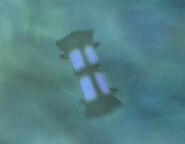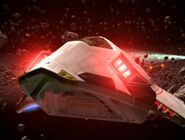| SMALLCRAFT CLASS | |
|---|---|
| Flyer-class shuttlecraft | |

| |
| Affiliation: | Federation, Starfleet; Khitomer Alliance; Terran Empire, Imperial Starfleet, Terran Empire, Imperial Starfleet (alternate mirror universe) |
| Classification: | shuttlecraft (heavy shuttle) |
| Service period: | 2375-2410s |
| Dimensions | |
| Length: | 21 meters |
| Width: | 12.2 meters |
| Height: | 5.3 meters |
| Decks: | 1 |
| Specifications | |
| No. of decks: | 1 |
| Capacity: | 1 crew, 6 passengers |
| Speed: | warp 3 |
| Maximum speed: | warp 6, warp 8.2 (upgrade) |
| Cruising speed: | warp 4 |
| Armaments: | 3 Type-V phaser arrays, photon torpedoes, quantum torpedoes, photonic missiles, pulse phased weapons |
| Defences: | Deflector shields, parametallic hull plating, unimatrix shielding, immersion shielding, duranium-reinforced hull |

| |
The Flyer-class was a type of Federation Starfleet heavy shuttlecraft in operation from the 2370s. The class was based on the design of the Delta Flyer and Delta Flyer II, designed and constructed by the crew of the USS Voyager while that starship was stranded in the Delta Quadrant. (VOY episodes: "Extreme Risk", "Imperfection")
Specifications[]
The original Delta Flyer was designed to survive the rigors of the Delta Quadrant and included Borg technology based on the knowledge of Seven of Nine, a liberated drone. The shuttlecraft was 21 meters long, 12.2 meters wide, and 5.3 meters high. Its normal cruising speed is warp 4, while its maximum cruising speed is warp 6. It has a standard mission duration of ten days.
The Flyer was armed with phasers and photon torpedoes. Its successor, the Delta Flyer II, was equipped with a single torpedo launcher for photonic missiles. The phasers could be switched to a pulse phaser mode.
The design was adaptable. Immersion shielding was added to allow a deep-sea operation in Monea's ocean. The standard configuration included unimatrix shielding, devised by tactical officer Lieutenant Commander Tuvok, and parametallic hull plating. The second Flyer featured a duranium-reinforced hull, and extendable impulse thrusters improved sublight speeds. (ST reference: The Official Starships Collection Issue 38)
The design was kept intact when Starfleet adopted the Flyer-class fleetwide. However, the warp nacelles were no longer extendable, and the primary impulse engines rendered extendable impulse thrusters superfluous. (STO - "The Klingon War" mission: "Welcome to Earth Spacedock")
History[]
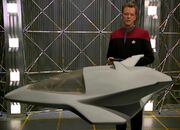
Design phase
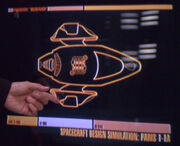
The original designs
Although Lieutenant Tom Paris had been petitioning his superiors on Voyager for some time to allow him to construct the first incarnation of the Delta Flyer, he had been overruled many times due to the vessel's lack of necessary resources to construct a new vessel from scratch.
While the crew realized that type 9 shuttles were becoming inadequate in the increasingly hostile Delta Quadrant, it took the near-loss of a multispatial probe to finally convince Captain Kathryn Janeway and Commander Chakotay to construct the vessel, Tom already had a shuttlecraft design simulation ready.
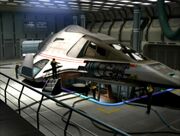
First Delta Flyer under construction
The vessel blended Starfleet and Borg technologies, and was designed in collaboration between Tom Paris, Lieutenant Junior Grade B'Elanna Torres, Lieutenant Typhuss James Halliwell, Lieutenant Commander Tuvok, Ensign Harry Kim and Seven of Nine. It featured an ultra-aerodynamic tetraburnium alloy hull, retractable warp nacelles, parametallic hull plating, unimatrix shielding, and a Borg-inspired weapon system, including photonic missiles, most of which were Paris' conceptions. For aesthetic reasons, Paris designed the flight controls to resemble those of 20th century aircraft. But to Paris' disappointment, the addition of dynametric tailfins was denied by Tuvok. (VOY episode: "Extreme Risk")
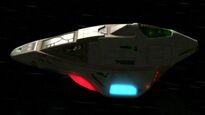
The Delta Flyer II
The success of the first Flyer gave the crew adequate reason to construct a second vessel in 2377 after the first one was destroyed during a Borg engagement. (VOY episodes: "Unimatrix Zero", "Drive")
When Voyager returned to the Alpha Quadrant in 2377, Starfleet Corps of Engineers immediately began to implement the design with a few upgrades to the Starfleet systems that Voyager didn't have during the ship's construction. Although somewhat resource intensive for a shuttlecraft, it paid itself off two-fold in its usefulness and abilities. Eventually the Flyer-class was available to larger starships, and generally only one was assigned per ship, although not obligatory. Starships with Flyer-class shuttles assigned to them are capable of running them on assignments at one time, freeing up the starship for possible other duties. In 2380, the Flyer-class Charger was refitted with an upgraded warp core, allowing it to reach maximum speeds of warp 8.2. (Star Trek: Intrepid)
Following her return to Federation territory during the Borg Invasion of 2381, the USS Titan had at least one Flyer-class shuttle, the Horne, added to her shuttle complement before she departed back into deep space to continue her mission of exploration. Of all Titan's shuttles the new Flyer-class was the fastest.
In that year Doctor Shenti Yisec Eres Ree, under the influence of his paternal instinct, kidnapped the pregnant Deanna Troi and stole the Horne when he felt Troi and her baby would not be safe on the Titan. Upon boarding the Horne, Ree tore out the pilot's chair to make a more comfortable position for his non-humanoid form to control the ship. He then used the ship's weapons systems to shoot an opening in the Titan's shuttlebay. permitting him to escape. (TTN novel: Over a Torrent Sea)
The Flyer-class was used in the mirror universe by the Terran Empire's Imperial Starfleet in the 25th century. The Flyer-class was still used by Starfleet in the 25th century. (STO video game: Star Trek Online)
The Flyer-class was used in the alternate mirror universe by the Terran Empire's Imperial Starfleet in the 24th century. (Star Trek: Terran Empire)
During the Typhon Pact war, the Flyer-class was mostly deployed on larger ships and starbases. It was used for high speed courier trips and in extreme cases added defense. While the Delta Flyer was highly maneuverable with good firepower for a vessel of the size, it wasn't built with combat in mind. As the war progressed, Delta Flyers were also used as high speed medical transports and in some cases high speed scouts for the fleet. (Starbase 400)
Technical data[]
Propulsion systems[]
Both versions of the Delta Flyer featured retractable warp nacelles, but while the first version only featured a standard impulse drive, the second version employed retractable impulse thrusters that greatly increased the vessel's impulse speed when deployed. (VOY episodes: "Extreme Risk", "Drive")
Additionally, the Delta Flyer's propulsion systems and hull integrity allowed the vessel to operate under water. (VOY episode: "Thirty Days")
- According to Star Trek: Starship Spotter, the Delta Flyer's warp nacelles were tuned circumferential warp drive units. The ship was capable of a cruising speed of warp 3 and a maximum speed of warp factor 6.
Tactical systems[]
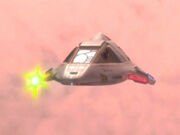
Firing a photonic missile
Both versions of the Delta Flyer featured phasers and photon torpedoes. Additionally, the first version was designed with a Borg-inspired weapons system created by Seven of Nine, which included photonic missiles. The second version of the vessel featured a pulse phased weapon system. Torpedo launchers were located both fore and aft, with the first version featuring two torpedo launchers on either side of the vessel facing forward, and the second vessel with a single launcher on the ventral surface. (VOY episodes: "Extreme Risk", "Imperfection")
In 2375, the Delta Flyer was designed to utilize immersive shielding and the unimatrix shield system designed by Lieutenant Commander Tuvok. Tetraburnium alloys were used in the vessels construction, in addition to parametallic hull plating. (VOY episode: "Extreme Risk")
Multi-adaptive shielding was incorporated to the Delta Flyer later in the same year. (VOY episode: "Dark Frontier")
The Delta Flyer II was upgraded to include pulse phased weapons and a duranium-enforced hull. (VOY episode: "Body and Soul")
Interior design[]
Command and control systems[]
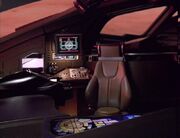
The cockpit
The cockpit of Flyer class shuttles featured workstations for tactical, operations, and engineering personnel. The helm was located in the front of the cockpit. While the tactical, ops, and engineering stations featured a standard Federation LCARS interface, the helm combined this with physical buttons, knobs, and levers to give the pilot more control over the vessel. The second vessel expanded upon this concept by replacing the LCARS display on the helm with two manual steering columns. (VOY episodes: "Extreme Risk", "Drive")
Crew accommodations[]

The aft compartment of the Delta Flyer
The Flyer's large size permitted comforts not standard to Federation shuttlecraft. The vessel featured a large aft compartment that featured a retractable biobed for medical situations. Despite this inclusion, the Delta Flyer's medical accommodations were limited and primarily intended to stabilize a patient until he or she could get back to Voyager for treatment.
Work stations were featured on either side of the bed and replicators were located at various points inside the craft. Flyer class shuttles were capable of accommodating up to five people comfortably. (Star Trek: Voyager)
While the interior was structurally solid, the compartments were apparently not designed to be completely soundproof from one another. Music played loudly enough could leak through to the other compartment. (VOY episode: "Renaissance Man")
Features[]

Cutaway

Side elevation
Among the many features included on the Delta Flyer were an ultra-aerodynamic tetraburnium alloy hull, retractable warp nacelles, parametallic hull plating, unimatrix shielding, and a Borg-inspired weapons systems, including pulse phasers and photonic missiles. Unlike any other Federation shuttlecraft before it, the Flyer class was a blend of Starfleet and Borg technology, and was designed to perform in situations that were deemed too hazardous for standard shuttlecraft. The Flyer class included a new type of thruster, polarity thrusters, of which the Delta Flyer II also had these. (Star Trek: Voyager)
The Flyer-class can be upgraded to reach maximum warp speeds of warp 8.2. This is done by upgrading the warp core. The Flyer-class can be upgraded to carry quantum torpedoes. The only Flyer-class shuttlecraft with these capabilities is the Charger. The Flyer-class sported pop-out impulse thrusters, which gave the ship greater sublight speeds. After learning and studying the Delta Flyer’s specs, sent to Starfleet via datastream transmission and later when Voyager returned to Earth, Starfleet decided to put the class in limited production. (Star Trek: Intrepid)
Known craft[]
| Starfleet shuttlecraft and auxiliary spacecraft classes | ||||||||||||||||||||||||||||||||||||||||||||||
|---|---|---|---|---|---|---|---|---|---|---|---|---|---|---|---|---|---|---|---|---|---|---|---|---|---|---|---|---|---|---|---|---|---|---|---|---|---|---|---|---|---|---|---|---|---|---|
| Federation, Starfleet | named classes | Aeroshuttle • Danube • Epoch • Flyer • Greyhound • McCall • Mercury (warpshuttle) • Pulsar • Sphinx • Tesla • Valkyrie • Venture (scout) • Waverider • Wraith • Yellowstone • Zodiac (warp shuttle) | alphanumeric designations | 2 • A • C • F • G • H • R10 • S3 • S4 • S5 • S6 • S7 • S10 • S11 • S12 • S20 • SC22 • SW7 • SW21 • I | 
| |||||||||||||||||||||||||||||||||||||||||
| type designations | type-1 • type-3 • type-4 • type-t4 • type 5-A • type-5 • type-6 • type-6A • type-6C • type-7 • type-8 • type-9 • type-9A • type-10 • type-11 • type-15 • type-15A • type-16 • type-17 • type-18 • type-18H • Zhang Sui | |||||||||||||||||||||||||||||||||||||||||||||
| others | mark II • captain's skiff • captain's yacht • Academy trainer craft • unnamed Federation shuttlecraft classes | |||||||||||||||||||||||||||||||||||||||||||||
| Federation, Starfleet (Kelvin timeline) |
military shuttle • passenger shuttle • Starfleet shuttle (2230s) | 
| ||||||||||||||||||||||||||||||||||||||||||||
